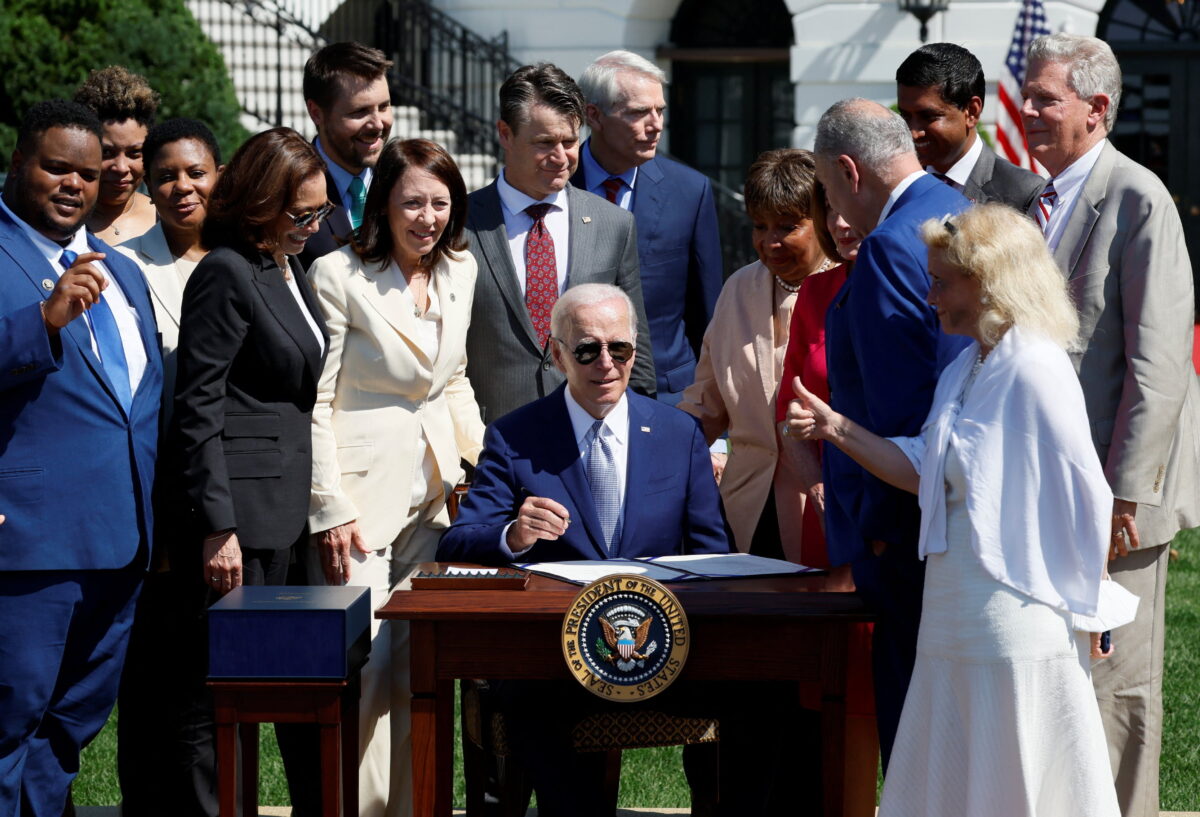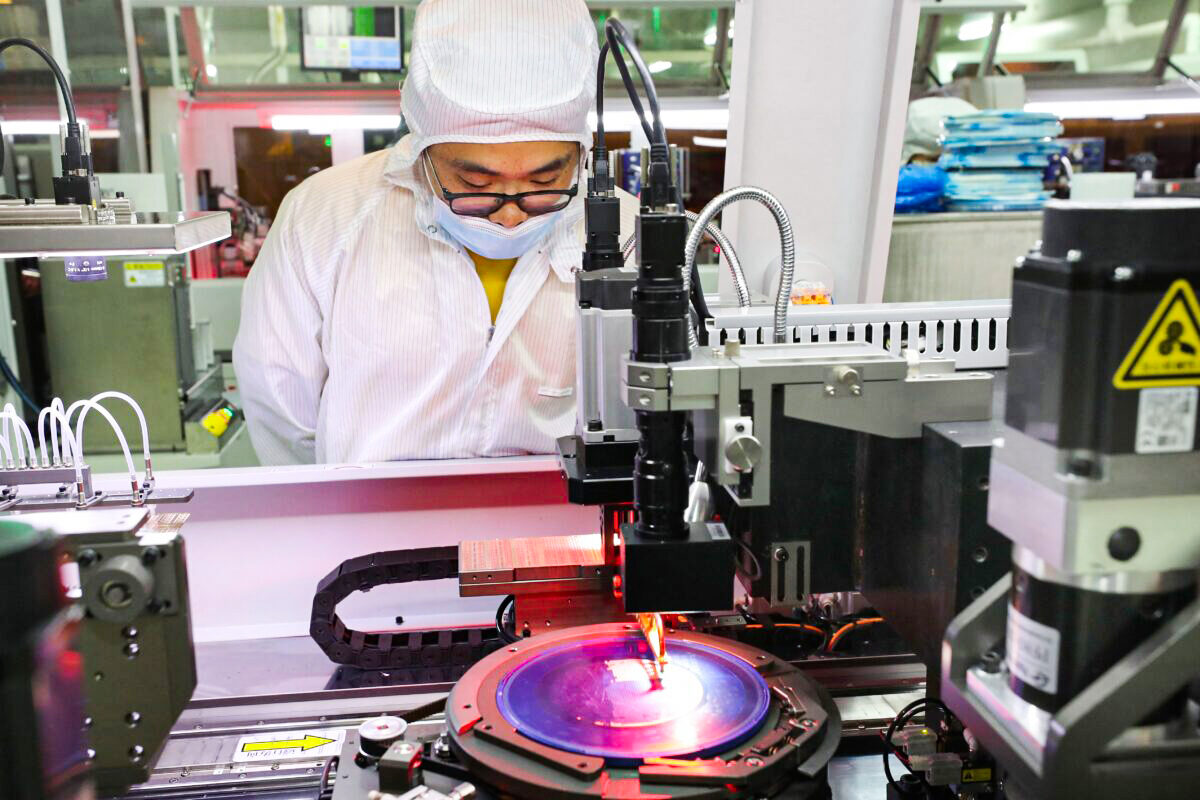Biden and Intel Are ‘Faking It Until They Make It’ on Reshoring Chip Fabs
CommentaryIntel, the American technology company that’s “Intel inside” so many American computers, is “planning” to build a new chip fab in Ohio. It would be great news for the state—and for America—if we could believe that it will really happen. As President Joe Biden said, we need to bring strategic industries, including semiconductors, back home. They’re needed for jobs, economic growth, resilient supply chains, and supercomputers. They power everything from new missile design to advances in artificial intelligence. Therefore, America’s future, and that of democracy globally, could depend on the success of the only American chip manufacturer that both designs and builds in America. The computer chip shortages currently costing billions in lost revenues for automobile companies—from America’s Ford to Germany’s BMW—are direct hits on democratic economies that must be strong to fund the defenses needed against Russia and China. U.S. Secretary of Commerce Gina Raimondo said in January: “Car prices are currently driving a third of inflation. Why? Because we don’t have enough chips.” In 2021, she said, American car manufacturers made nearly 8 million cars fewer than they would have, but for the chip shortage. Ford CEO Jim Farley poses for a photo at the launch of the all-new electric Ford F-150 Lightning pickup truck at the Ford Rouge Electric Vehicle Center in Dearborn, Michigan, on April 26, 2022. (Bill Pugliano/Getty Images) We need more chip supply, which can be achieved by building new fabs in America. That’s exactly what Intel claims to be doing. “We’re going to build the most advanced stuff in the world, right here, in Ohio,” Intel CEO Patrick Gelsinger said at the Ohio plant ground-breaking on Sept. 9. “We put our chips on the table, to help the U.S. regain its manufacturing heart, as well as unquestioned technology leadership.” Biden attended the event. He and Raimondo met Gelsinger at the White House in January to announce Intel’s $20 billion investment. Biden’s Chips and Science Act of 2022 includes subsidies of almost $53 billion for new chip fab capacity in America. But all of this isn’t enough. According to The Wall Street Journal, Intel’s plan to expand its production capacity in the United States “will build the factory structures first and equip them only when demand materializes.” (The italics are mine.) Biden is milking Intel’s “planned” investment for all it’s worth and getting great press from the Ohio plant but not doing enough to actually get the factories—each set of which will likely cost about $100 billion at full steam—running. So far, only $20 billion is planned to create the factory shells in Ohio. Even that was just aspirational at the point of the January announcement, according to a disclaimer at the end of Intel’s press release. Intel is partnering on its new American fabs, including one in Arizona, with a private equity firm called Brookfield. Intel also plans fabs in Mexico and Germany. Each new fab can cost over $100 billion, considering that the $53 billion in total subsidies to American chip manufacturing isn’t much. Even after subsidies and co-investment from companies like Brookfield, according to the Journal, Intel will need to increase capital expenditure to over 35 percent of annual sales in the coming years, which sounds like “faking it until it makes it.” Therefore, we must ask: Is America really doing enough for Intel? What will it take to obtain an actual commitment from Intel to get more American factories running? Stalled automobile assembly lines need real factories producing real chips, not just grandstanding politicians and empty factories waiting for the right demand signals. President Joe Biden signs the CHIPS and Science Act of 2022 alongside Vice President Kamala Harris, House Speaker Nancy Pelosi, and Joshua Aviv, founder and CEO of SparkCharge, on the South Lawn of the White House in Washington on Aug. 9, 2022. (Evelyn Hockstein/Reuters) The real problem is an uncompetitive high price point at which Intel can produce chips in the United States. Foreign chips are cheaper, in large part because of massive foreign subsidies, lower labor and regulatory costs, and chip companies in Taiwan and South Korea that have consequently pulled ahead in terms of process technology. Losing America’s competitive edge in chip manufacturing to vulnerable fabs in Asia, as Biden said, should not be an option. Gelsinger has truly led by doubling down on his plans for American chip manufacturing despite these disadvantages, including costs that are 30-50 percent higher than in Asia. That patriotism, unfortunately, put downward pressure on Intel’s stock price, which slipped 50 percent since Gelsinger took control in early 2021. Conversely, American chip companies that focus on design at home, but manufacture exclusively abroad, are rewarded in the markets, with AMD’s market capitalization exploding since 2018 by almost 1,000 percent to now rival Intel. AMD’

Commentary
Intel, the American technology company that’s “Intel inside” so many American computers, is “planning” to build a new chip fab in Ohio. It would be great news for the state—and for America—if we could believe that it will really happen.
As President Joe Biden said, we need to bring strategic industries, including semiconductors, back home. They’re needed for jobs, economic growth, resilient supply chains, and supercomputers. They power everything from new missile design to advances in artificial intelligence.
Therefore, America’s future, and that of democracy globally, could depend on the success of the only American chip manufacturer that both designs and builds in America.
The computer chip shortages currently costing billions in lost revenues for automobile companies—from America’s Ford to Germany’s BMW—are direct hits on democratic economies that must be strong to fund the defenses needed against Russia and China.
U.S. Secretary of Commerce Gina Raimondo said in January: “Car prices are currently driving a third of inflation. Why? Because we don’t have enough chips.” In 2021, she said, American car manufacturers made nearly 8 million cars fewer than they would have, but for the chip shortage.

We need more chip supply, which can be achieved by building new fabs in America. That’s exactly what Intel claims to be doing.
“We’re going to build the most advanced stuff in the world, right here, in Ohio,” Intel CEO Patrick Gelsinger said at the Ohio plant ground-breaking on Sept. 9. “We put our chips on the table, to help the U.S. regain its manufacturing heart, as well as unquestioned technology leadership.”
Biden attended the event. He and Raimondo met Gelsinger at the White House in January to announce Intel’s $20 billion investment. Biden’s Chips and Science Act of 2022 includes subsidies of almost $53 billion for new chip fab capacity in America. But all of this isn’t enough.
According to The Wall Street Journal, Intel’s plan to expand its production capacity in the United States “will build the factory structures first and equip them only when demand materializes.” (The italics are mine.)
Biden is milking Intel’s “planned” investment for all it’s worth and getting great press from the Ohio plant but not doing enough to actually get the factories—each set of which will likely cost about $100 billion at full steam—running. So far, only $20 billion is planned to create the factory shells in Ohio. Even that was just aspirational at the point of the January announcement, according to a disclaimer at the end of Intel’s press release.
Intel is partnering on its new American fabs, including one in Arizona, with a private equity firm called Brookfield. Intel also plans fabs in Mexico and Germany. Each new fab can cost over $100 billion, considering that the $53 billion in total subsidies to American chip manufacturing isn’t much.
Even after subsidies and co-investment from companies like Brookfield, according to the Journal, Intel will need to increase capital expenditure to over 35 percent of annual sales in the coming years, which sounds like “faking it until it makes it.”
Therefore, we must ask: Is America really doing enough for Intel? What will it take to obtain an actual commitment from Intel to get more American factories running? Stalled automobile assembly lines need real factories producing real chips, not just grandstanding politicians and empty factories waiting for the right demand signals.

The real problem is an uncompetitive high price point at which Intel can produce chips in the United States. Foreign chips are cheaper, in large part because of massive foreign subsidies, lower labor and regulatory costs, and chip companies in Taiwan and South Korea that have consequently pulled ahead in terms of process technology.
Losing America’s competitive edge in chip manufacturing to vulnerable fabs in Asia, as Biden said, should not be an option.
Gelsinger has truly led by doubling down on his plans for American chip manufacturing despite these disadvantages, including costs that are 30-50 percent higher than in Asia. That patriotism, unfortunately, put downward pressure on Intel’s stock price, which slipped 50 percent since Gelsinger took control in early 2021.
Conversely, American chip companies that focus on design at home, but manufacture exclusively abroad, are rewarded in the markets, with AMD’s market capitalization exploding since 2018 by almost 1,000 percent to now rival Intel.
AMD’s market success is through subcontracting most of its chip manufacturing to TSMC in Taiwan.
TSMC is the world’s most valuable chip-making company, but that honor should be on American shores. Intel should be rewarded by America—not punished—for reshoring chip manufacturing.
Biden rewards Intel with moral support and pointedly leaves AMD out of his speeches. But moral support does not pay Intel’s $100 billion bills or impress the stock market.
Taiwan garners 73 percent of the world’s contract revenues for chips, with the United States only getting 10 percent and South Korea 6 percent. Intel needs more of America’s tangible support to claw back a large portion of that global market share.
TSMC and Samsung have both pulled ahead of Intel in terms of process technology, and AMD’s cheaper foreign-made chips are cannibalizing Intel’s market share. Taiwan and South Korea are at least U.S. allies, but if those supply chains broke for any reason—for example, expanded Chinese military operations against Taiwan or in the South China Sea—America’s economy and defense production would be at even greater risk than it is today.
America’s failure in the 2000s to protect American chip manufacturing was a mistake that put our defense, technological, and manufacturing future at the mercy of decisions made in Beijing.
American chip designers, who think they hold the trump card in their intellectual property, are wrong. In fact, up to $600 billion worth of American IP is stolen every year by China.

The Chinese Communist Party (CCP), by definition, does not care about America’s so-called rights to property.
We can’t fight the CCP with purely market solutions. Shareholders do not want to bear the costs today of risk mitigation and national security–neither do taxpayers. So we have to appeal for government action.
Biden pays lip service and puts some legislative weight and subsidies into buying American. Still, even one of his flagship projects, the Intel plant in Ohio, has no concrete commitment to actually produce chips.
We aren’t setting Intel and America up for success because we, as a nation, are not yet willing to pay the necessary costs. The Biden administration, including Raimondo, is still talking about rolling back the Trump administration’s tariffs on China when we should be talking about expanding them.
That attitude must change if we are to defend America and, with it, democracies around the world. Setting subsidies and tariffs on computer chips at high enough levels to get from “plans” to “commitments” on American manufacturing is the necessary next step. Lip service and caveats will never be enough.
Views expressed in this article are the opinions of the author and do not necessarily reflect the views of The Epoch Times.












